In November, David Wagnon of Brouwerij Van Steenberge flew to Manila for the third time to spread the gospel of fine Belgian beers. Founded in Ertvelde in 1784, Brouwerij Van Steenberge is part of a long list of proud Belgian breweries. Like other breweries in the country, Van Steenberge employs traditional Flemish brewing techniques that have since been passed down for several generations.
Before we embark on a sensory exploration of the beers presented by David at Spektral Beer Lounge, we look first at these beers from a historical perspective to learn why beers from this country are very distinct. As in many countries, taxation policies and World Wars have forever changed the trajectory of Belgium’s history, together with it, its beers.
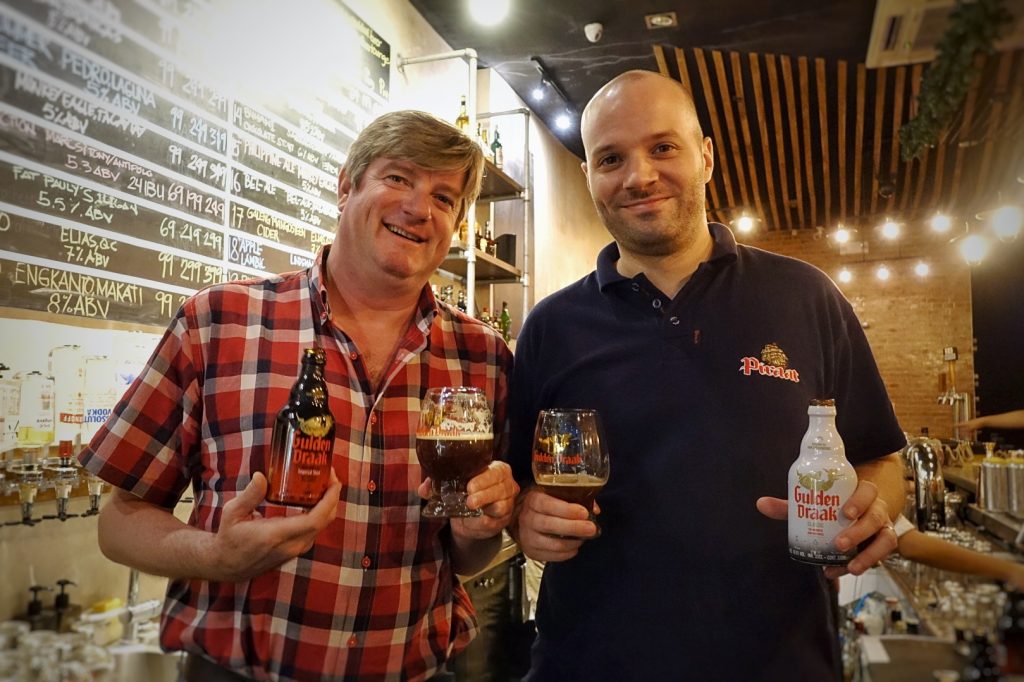
THE 19TH CENTURY: BELGIAN BEERS OF THE OLD
Belgian beers in the 19th century were from a different era. In this period, the taxes levied on these breweries did not depend on the volume or the alcohol content of the beer, but on the size of the brewery’s mash tun. The brewers responded by resorting to tiny mash tuns and by using extremely thick mashes in their brewing. These circumstances yielded a wide range of “old fashioned” Belgian beers, of which four are listed below:
- Bière de Diest. This beer is a strong golden ale that was known to have a creamy, honey-like flavor. Female wet nurses said to have enjoyed this beer because it was comforting and nutritious.
- Hoegaarden Beer. This is not to be confused with the Belgian wheat beer being sold currently. The original 19th century Hoegaarden is very pale in color and was noted to have a raw, wild, yet refreshing taste.
- Flemish Brown Beer. Boiled up to twenty hours, Flemish brown beers were noted to be “far from being very pleasant” given its bitter, harsh, and astringent profile.
- Liège Saison. This rustic ale was often made largely of spelt or hulled wheat and was aged from four months to two years.
THE 20TH CENTURY: THE RISE OF THE TITANS
These beers of the old may have survived the two World Wars but they did make it through the modernization era of the brewing industry in Belgium. In 1900, Belgium had over 3,000 breweries, but only 1,500 were left by the middle of the century. By the 1990s, there were only 115 breweries remained.
The two titans, Anheuser-Busch InBev (then Interbrew) and Heineken dominated the market where the independent or family-owned breweries operated in. These smaller and traditional Belgian breweries now have to compete against the macro-owned brands, Hoegaarden, Leffe, and Stella Artois, to name a few. And as these conglomerates continue to consolidate the market, the independent breweries now have to depend heavily on the discerning tastes of their local drinkers and on the export markets to keep themselves afloat.
SEVEN GENERATIONS OF BREWING HERITAGE
The Philippines is no stranger to Belgian beers. Hoegaarden, Leffe, and Stella Artois are already well-known brands in the country. However, there is more to Belgian beer than Hoegaarden, Leffe, and Stella Artois given that there are at least 160 breweries in Belgium that produce a very wide array of beers.
One of these breweries is Brouwerij Van Steenberge, established by Jean Baptiste De Bruin in 1874. Members of the family such as Angelina Petronella Schelfaut, Jozef Schelfauttook, and Paul Van Steenberg took on the reins of the brewery at different periods following the passing of De Bruin. In 1978, the brewery acquired the recipe of the traditional abbey beer of St. Augustine’s Abbey in Ghent. This beer was then introduced to the market four years later.
In 1998, the nephew of Paul Van Steenberge, Jef Versele, joined the brewery as the seventh generation brewer. With Jef’s efforts, exports of the brewery’s top-fermented beers, mainly to the United States, Netherlands, and Italy, have increased to 60 percent of total volume. In 2017, the Philippines was finally on the list of Van Steenberge’s export destinations thanks to Les Deux Belges.
MAKINGS OF BELGIAN BEER
With the diversity and complexity of the brewing industry in this nation, defining a Belgian beer can be quite tricky. There are Trappist beers brewed by Trappist monks. Trappist breweries include Brouwerij de Sint-Sixtusabdij van Westvleteren, Westmalle Brewery, and Rochefort Brewery among others. There are commercial beers such as Hoegaarden, Stella Artois, and Leffe. Further, there are beers brewed by Belgian Family Brewers (BFB) such as Dubuisson, Lindemans, and Lefebvre. And there are craft beers brewed by the likes of Brussels Beer Project.
What is an authentic Belgian beer?
There are several associations in Belgium that certify the different types of Belgian beers. For instance, for a beer to be certified by the BFB as an authentic Belgian beer, it should (1) be brewed in Belgium on a brewery site recognized by BFB; (2) come from an independent family brewery with at least 50 years of brewing experience; and (3) be a beer with no copies. Further, the BFB highlights that a beer that has not been brewed or bottled in Belgium can only be referred to as a “Belgian-style beer” and not a “Belgian beer.”
“Belgian Brewers” is one of the oldest professional associations around the world and almost all Belgian brewers belong to it. The Association provides more stringent guidelines in certifying specific beer styles from this country. For example, a “Certified Belgian Abbey Beer” should, among others, (1) be brewed in an existing non-Trappist abbey and (2) be based on historical background. Meanwhile, an “Authentic Trappist Product” must (1) be brewed within the walls of a Trappist abbey; (2) be brewed under the control of Trappist monks; and (3) the economic purpose of the brewery must be directed toward assistance and not toward financial profit.
What makes Belgian beers very distinct?
The diversity and distinctiveness of Belgian beers may be attributed largely to the yeast strains Belgian brewers use. Although most of these beers are not fermented using truly wild organisms as in the case of lambics and the oud bruins of Flanders, Belgian yeast strains are highly distinctive and characterize heavily the beer it ferments. For instance, Belgian beers that have fruity and spicy aromas were most likely fermented at relatively high temperatures using the mentioned yeast strains. In fact, any wort fermented with a Belgian yeast strain will lead to a Belgian-tasting or Belgian-style beer.
Aside from yeasts, Belgian beers are also largely influenced by the malts used. Hops from this country have generally and traditionally been aromatic hops and thus have very low bittering characteristics. While the American beer styles boast of hop-driven IPAs, the locals typically prefer their beers to be more layered and be influenced less by hop aromas. In fact, the malty flavors of some Belgian beers may be contributed by dark-cooked caramel syrup. Although excess usage is bad, these types of syrups are used to mellow down the stronger beers to make them more drinkable.
Another factor behind the diversity of these beers is the absence of a “Purity Law.” Unlike Germany, Belgium never had a Reinheitsgebot or “Purity Law.” Under this 1516 decree, only water, barley, and hops were the permitted ingredients to make beer in Germany. It was not until the 19th century that yeast was discovered to have played a vital role in fermenting beer and was then included in the list. The absence of this law in Belgium, therefore, allowed the old traditions of adding herbs and spices in beer as substitutes for hops. For instance, some Belgian wheat beers are brewed using bitter orange peel and coriander. Moreover, Belgian strong pale beers can be brewed with grains of paradise, an African relative of cardamom, while licorice and star anise can also be considered as additions to the darker beers.
THE BEERS OF BROUWERIJ VAN STEENBERGE
The masterclass with David Wagnon was dedicated to knowing seven traditional and contemporary beers from the brewery. Learning about Belgian beers and the breweries through the books may be a good start, but the best way to study beer is by drinking.
Baptist Wit (5% ABV)
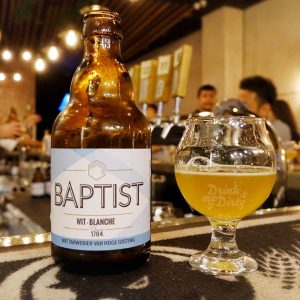
STYLE GUIDELINES
This beer is being evaluated as a Witbier (24A) in the context of the 2015 Beer Style Guidelines of the Beer Judge Certification Program (BJCP). The most current version of the guidelines can be found on the BJCP website.
TASTING NOTES
Wit Blanche is a refreshing Belgian wheat beer with aromas of sourdough and light malts. Common wheat beer profiles of coriander and bread aptly characterize the palate. There is relatively muted sweetness compared to its commercial counterparts.
Baptist Saison (6.5% ABV)

STYLE GUIDELINES
This beer is being evaluated as a Saison (25B) (Strength: Standard) in the context of the 2015 Beer Style Guidelines of the BJCP. The most current version of the guidelines can be found on the BJCP website.
TASTING NOTES
This saison pours partly-cloudy orange-yellow color. The nose is a basket of dried grass, light malts, caramel bars, and some ripe fruits. A light-bodied beer, this saison returns notes of raspberries, coriander, apples, with a malty backbone. The light maltiness and dried grass linger after, with some indistinct toasted notes follow. Overall, Baptist Saison is a very flavorful variant of this style.
Baptist IPA (6.7% ABV)
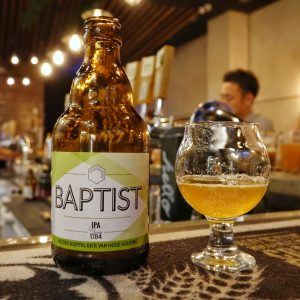
STYLE GUIDELINES
This beer is being evaluated as a Specialty IPA: Belgian IPA (21B) in the context of the 2015 Beer Style Guidelines of the BJCP. The most current version of the guidelines can be found on the BJCP website.
TASTING NOTES
Van Steenberge shows us what they can do outside the realm of traditional Belgian styles with this India Pale Ale. This IPA has tamed aromas of perfume and hops. It is a light-medium bodied IPA with strong pine and dried grass notes. An unexpected creamy mouthfeel is something worth mentioning. After the first sip, pine hoppy notes linger on. Very good.
Piraat (10.5% ABV)
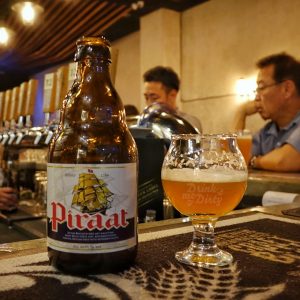
Now, on to the heavyweights. Piraat was created upon the request of the brewery’s Italian importer. It is a triple amber ale that referments in the bottle, brewed with three malt varieties (Pale Ale, Pilsner, and Munich) and two hop varieties (Aurora and Petra hops).
STYLE GUIDELINES
This beer is being evaluated as a Belgian Golden Strong Ale (25C) in the context of the 2015 Beer Style Guidelines of the BJCP. The most current version of the guidelines can be found on the BJCP website. As of this writing, this beer is noted as a commercial example of the style.
TASTING NOTES
This flagship Piraat has a cloudy sunset orange color. The nose evoked orange jam. With a medium-body, Piraat is characterized by marmalade, malts, and butterscotch. Its finish is of oranges and burnt sugar. It truly is a flavorful citrus-driven beer– Van Steenberge’s answer to the hoppy India Pale Ale.
Piraat Triple Hop (10.5% ABV)

STYLE GUIDELINES
This beer is being evaluated as a Belgian Golden Strong Ale (25C) in the context of the 2015 Beer Style Guidelines of the BJCP. The most current version of the guidelines can be found on the BJCP website.
TASTING NOTES
Brewed using the famous Piraat ale as the base, this Triple Hop version seems to bring the best of both the hops and malts. Aside from a balanced aroma of freshly squeezed oranges, this Belgian Strong Ale also has a medium body. The palate is composed of sweet syrup and caramel bars and is further balanced with slight hop bitterness. Some lingering sweetness was noted, akin to artificial sugar sweeteners.
Gulden Draak Classic (10.5% ABV)
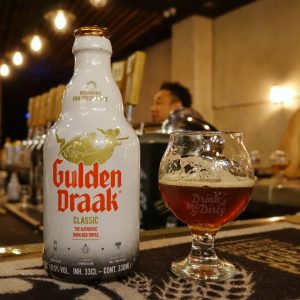
Gulden Draak is the iconic Belgian beer that pays homage to the golden dragon at the top of the Belfry of Ghent. This was originally a one-off beer commissioned by the mayor of Evergem. However, when some Italian guests tasted and enjoyed the beer, they insisted that Gulden Draak be included as a brewery staple.
STYLE GUIDELINES
This beer is being evaluated as a Belgian Dark Strong Ale (26D) in the context of the 2015 Beer Style Guidelines of the BJCP. The most current version of the guidelines can be found on the BJCP website.
TASTING NOTES
This Belgian strong dark ale is a very aromatic beverage, with caramels, rum, cherries, and apples stepping forward. It is a medium-bodied beer with a mouthful of flavors coming through. Delectable notes of toffee, bread pudding, apples, pears, Biscocho, and caramel bars. A finish of Biscocho and pears linger after a sip. Gulden Draak is a dangerously drinkable strong dark ale that could very well be a gateway beer to those wanting to experience the more sophisticated beers of Belgium.
Gulden Draak Brewmasters Edition (2019) (10.5% ABV)
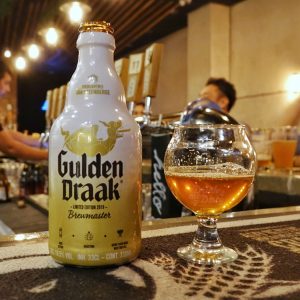
This Brewmaster Edition of the Gulden Draak was crafted by brewmaster Jef Versele in honor of his grandfather, Jozef Van Steenberge, and the 230th anniversary of the brewery. This special variant of the Gulden Draak was matured in whisky barrels. Unfortunately, the maturation age and type of whisky barrels used cannot be disclosed by David Wagnon.
STYLE GUIDELINES
This beer is being evaluated as a Specialty Wood-Aged Beer (33B) with the Belgian Golden Strong Ale (25C) as the base style in the context of the 2015 Beer Style Guidelines of the Beer Judge Certification Program (BJCP). The most current version of the guidelines can be found on the BJCP website.
TASTING NOTES
The nose picked up light caramel notes and oak. At 10.5 percent, this barrel-aged Gulden Draak has a light-to-medium body, with flavors of whisky, maltiness, oak making their presence known. The second wave of flavors comes in: sweet apples and caramel. Whisky and oak notes then follow while a similar profile lingers as the finish. Overall, this 2019 edition of the Gulden Draak Brewmaster is a proper Belgian take on whisky barrel-aged beers. However, as avid whisky drinkers, we think more whisky notes would be more exciting.
Gulden Draak Imperial Stout (12% ABV)
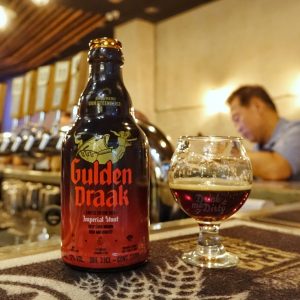
STYLE GUIDELINES
This beer is being evaluated as an Imperial Stout (20C) in the context of the 2015 Beer Style Guidelines of the Beer Judge Certification Program (BJCP). The most current version of the guidelines can be found on the BJCP website.
TASTING NOTES
The last in a flight is a limited edition Imperial Stout from the noble line of Gulden Draak beers. While the nose reveals toasted malts, its palate showcases a more complex profile of luscious chocolates, toasted caramel, cherries, and cocoa powder. Although this Imperial Stout leans towards the sweeter side at 12 percent ABV, it is as dangerously drinkable as the Gulden Draak Classic.
REFERENCES AND RECOMMENDED READINGS:
- The Beer Bible by Jeff Alworth (2015)
- Belgium Beer Tourism
- Belgian Brewers
- Belgian Family Brewers
- Brouwerij Van Steenberge
- Private Brauereien
- Tasting Beer: An Insider’s Guide to the World’s Greatest Drink by Randy Mosher (2009)






Where can you buy the more unusual belgian beers in Manila? Thanks. Dean.
Hi Dean! You may check out the website of The Two Belgians for deliveries. They currently have an awesome promo going on.
https://www.lesdeuxbelges.com/
Cheers
-Miguel